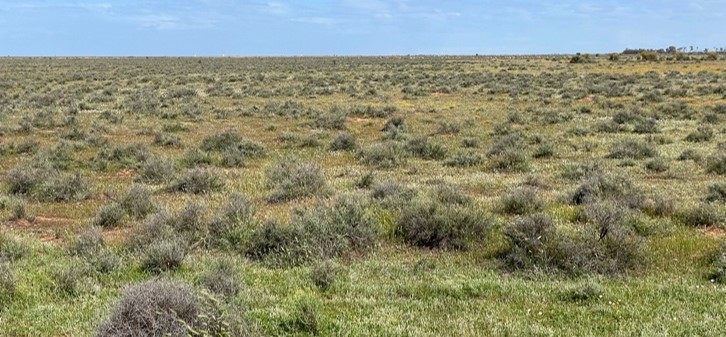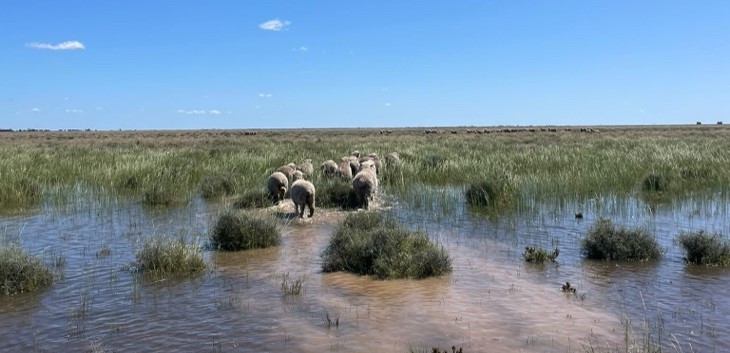Producer case study: Stacey & Ian Lugsdin, Warrendale
The property
'Warrendale' is located approximately 45km north-east of Hay in Central NSW. Receiving an average 340mm of rainfall annually, paddock feed predominantly consists of forage bushes (like cotton bush), with medics and grasses depending on seasonal conditions. The Lugsdin Family run a self-replacing, non-mulesed Merino flock, joined in November. Sheep are stocked at a low density due to limited paddock availability.
Sheep farming on the Hay Plains
The Lugsdin family experienced a pivotal year in 2019. After a string of dry years, poor lamb marking results, and heavy lamb losses from mulesing, they knew they needed to change what they were doing for the sustainability of their business and the wellbeing of the sheep.
That year, the Lugsdins ceased mulesing and began to pregnancy scan for multiples to manage the ewes according to their pregnancy status. Their marking percentage increased by 30% compared to the previous four years, which was also helped by an improvement in seasonal conditions.

Plenty of feed after a wetter than average season.
Getting involved
While Stacey and Ian had already made considerable progress with their management and marking percentages, they thought there was still room for improvement.
The Lugsdins were keen to find out why their marking results weren’t as good as they expected and wanted to better utilise the individual sheep data collected through eIDs.
The project
This three-year mentoring program aimed to increase the reproduction rate of extensive sheep flocks in Central and Western NSW during the 2022 and 2023 breeding seasons.
With support from the project team (Laura Broughton of Productive Livestock Systems, and Sue Hatcher of Makin Outcomes), Core producers implemented flock management techniques such as optimising joining length, best practice pregnancy scanning, wetting and drying ewes at marking, culling strategies to identify and retain the best breeding ewes, condition scoring ewes to manage their nutrition, and the use of electronic ID systems to capture data and inform flock management decisions.
The impact of these management techniques on net reproductive rate (NRR: lambs weaned/ewes joined) was evaluated using annual benchmarking questionnaires.
Key learnings
- Proving the benefits of pregnancy scanning and condition scoring on Warrendale itself was important for the practices to be adopted long term by the whole family, as it does involve additional labour to complete the activities. Support from the project team helped keep the Lugsdins on track while trialling the tools.
- Increasing condition score at joining and removing twice dry ewes can significantly improve the pregnancy scanning percentage.
- It is easier to make a decision when it is supported by data. Record keeping systems are needed that allow for data to be easily accessed and analysed so the information can contribute to management decisions.
- Removing passengers (i.e. twice-empty and lambed and lost ewes) from the breeding flock means the limited feed resources are going towards productive animals.
- Improving the reproductive rate provides additional management and selection opportunities, improving productivity and genetic gain.
- Twin-bearing ewes performed extremely well when managed separately, even without supplementary feed.
Condition score improves conception
Improving condition score pre-joining significantly improved pregnancy scanning percentage in 2022:
- 1 extra condition score at joining = 23% extra foetuses scanned
Measure to manage
A key benefit of the trial was that it highlighted the value of using data to monitor the breeding flock’s performance. Data collected on a mob basis or for individual sheep through eID tags can be used to identify opportunities to further improve flock performance, or potential issues within the flock.
Analysing individual ewe data from 2021 (pre-project) and 2022 showed that retained scanned-empty ewes had a significant impact on overall flock production. In 2022, removing twice empty ewes improved the pregnancy scanning percentage by 7%.
The trial also showed that simple spreadsheets capturing key reproduction metrics on an annual basis (such as ewe, ram and/or lamb counts at joining, pregnancy scanning, marking and weaning) are sufficient to track flock reproductive performance over time and can identify areas for improvement.
Productivity provides opportunity
Having ceased mulesing, the Lugsdins have strict selection criteria for their breeding ewes with flystrike resistance being of particular importance. By increasing their reproductive rate and the number of replacement ewe lambs as a result, Stacey and Ian can select future breeders based on breech wrinkle as well as wool traits, finding a balance between resilience and production.
Where to from here
The Lugsdins will continue to pregnancy scan for multiples, condition score more regularly throughout the breeding cycle, and use supplementary feed strategically to meet the ewes’ nutritional requirements. They will also remove passengers from their breeding flock by selling any mature scanned-empty ewes and lambed and lost ewes at marking.




